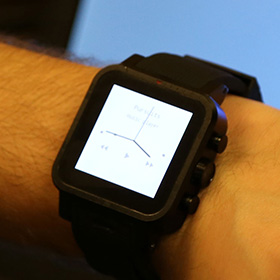Recent Stories
- Businesses urged to tap into science and technology young talent
- Digital relay baton enables remote crowd cheering of athletes
- Health Innovation Campus moves a step closer
- £7.1 million R&D boost for North West businesses
- Centre of excellence created for the next industrial revolution
- Artificial intelligence toolkit spots new child sexual abuse media online
- Strategic partnership set to help plug cyber security skills gap
- What your choice of smartphone says about you
- InfoLabTree: Discover the Story
- novi.digital Launch Event - 'An Event to Help Businesses Grow Online'
RSS Feeds
RSS feeds can deliver the latest InfoLab21 news and events direct to your browser without you having to visit the website.
In most browsers you can click on an RSS link and choose to subscribe to the feed to add it to your favourites or bookmarks.
Revolutionary eye-tracking technology for smart watches

Future smart watches could go hands-free thanks to eye-tracking technology that is literally revolutionary.
Whether choosing music tracks, responding to missed calls or checking social media notifications, the technology, called Orbits, allows smart watch wearers to select a function at a glance. Users can effectively press buttons and turn dials displayed on the watch simply by having their eyes briefly follow a small token orbiting the dial.
In a paper – Orbits: Gaze Interaction for Smart Watches using Smooth Pursuit Eye Movements – which won best paper at the ACM Symposium on User Interface Software and Technology (UIST) on November 10, researchers from Lancaster University were able to demonstrate that users robustly select from up to eight moving input targets while avoiding any unintended activation when they just look up the time or other information displayed.
Researchers at Lancaster University’s School of Computing and Communications have taken advantage of ‘smooth pursuits’ – a distinctive form of eye-movement that only occurs when we fixate on a moving target.
Because this trait only happens when following a stimulus it ensures a high degree of accuracy. After a short initial acceleration the eye converges with the target within 300 milliseconds, so functions can be selected very quickly. In addition, the smooth pursuits trait also means no irritating calibration between the eye-tracker and display is required.
The technology works independently of the target’s size, so it is better suited to the small screen sizes of devices like smart watches than other existing forms of interaction, such as touchscreens.
Dr Eduardo Velloso, one of the researchers developing Orbits, said: “Our eyes spend most of the time either fixating at a point or making sudden, jerky movements. The only time when they make a smooth movement is when following a moving object. We can then compare the movements of the eyes and the targets on the screen to determine which one the user is looking at.
“Orbits are a novel technique that accounts for the limited space of smart watches and the spontaneous natural behaviour of glancing at a watch.”
Orbits’ targets move in circular trajectories – both clockwise and anti-clockwise – on the watch face and by following them as they rotate for around a second the function the target corresponds to – such as Facebook notifications – can be selected.
The researchers have designed three different displays to demonstrate how Orbits work: including a music player where volume can be changed and tracks skipped or paused; a notifications screen in which social media platforms were represented by different colour targets moving in trajectories of increasing size due to the number of notifications pending; and a missed-call menu that allows wearers to call-back, reply with a text message or store the number for later.
Hans Gellersen, Professor of Interactive Systems at Lancaster University, said: “The first wrist-watches were developed more than 100 years ago by Louis Cartier. Over more than a century we have grown used to using watches just by glancing at them.
“As watches are becoming increasingly sophisticated through the addition of digital functions, Orbits are a natural and highly accurate way of continuing this tradition of using our eyes to tell the time, and also communicate with our friends and accessing entertainment.”
Multiple targets up to an optimum of eight can be incorporated by offsetting starting positions and varying angular speeds, as well as directions of movements.
Although other forms of eye-tracking technologies for smart watches are in development, they rely on unnatural sideways glances. Currently the technology uses head-mounted eye-trackers, however it is predicted that eye-trackers will be built-in to smart watches in the future. This technology is already being developed by companies such as EyeTribe.
Watch a video of how Orbits work
Orbits researchers were Augusto Esteves, Eduardo Velloso and Hans Gellersen from Lancaster University and Andreas Bulling from the Max Planck Institute for Infomatics.
More information on Lancaster University’s School of Computing and Communications
Tue 26 January 2016



